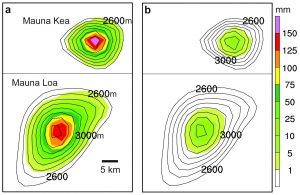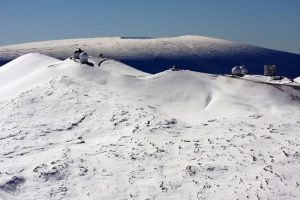4 May 2017
Hawaiian mountains could lose snow cover by 2100
Posted by Nanci Bompey
By Rachel Lentz
Daydreams of the tropical paradise of Hawaiʻi rarely include snow in the imagery, but nearly every year, a beautiful white blanket covers the highest peaks in the state for at least a few days. However, systematic observations of snowfall and the snow cover dimensions on Mauna Kea and Mauna Loa are practically nonexistent.
A group of climate modelers led by Chunxi Zhang from the International Pacific Research Center (IPRC) at the University of Hawaiʻi at Mānoa used satellite images to quantify recent snow cover distributions patterns. They developed a regional climate model to simulate the present-day snowfalls and then to project future Hawaiian snowfalls.
Their results, accepted for publication in Earth’s Future, a journal of the American Geophysical Union, indicate that the two volcano summits are typically snow-covered at least 20 days each winter, on average, but that the snow cover will nearly disappear by the end of the century.

Long term annual snowfall on Mauna Loa and Mauna Kea on Hawaiʻi Island. a) Current average snowfall (in mm of liquid water equivalent) b) Projected snowfall by 2100, from model run with moderate emissions scenario. Topographic contour interval is 200 m.
Credit: Zhang et al
To evaluate the current situation, Zhang and his colleagues examined surface composition data retrieved from satellite imagery of Hawaiʻi Island from 2000 to 2015 to construct a daily index of snow cover. They used this data compilation to evaluate the quality of their regional atmospheric climate model, based on global climate projections that included several scenarios of anticipated climate change. Zhang then ran simulations representative of the end of the 21st century, assuming a moderate business-as-usual scenario for greenhouse gas emissions projections, to establish how long Hawaiʻi might enjoy its occasional glimpses of white-topped mountains.
“We recognized that Hawaiian snow has an aesthetic and recreational value, as well as a cultural significance, for residents and visitors,” explained Zhang. “So, we decided to examine just what the implications of future climate change would be for future snowfall in Hawaiʻi.” Unfortunately, the projections suggest that future average winter snowfall will be 10 times less than present day amounts, virtually erasing all snow cover.
The findings were not a total surprise, with future projections showing that even with moderate climate warming, air temperatures over the higher altitudes increase even more than at sea level, and that, on average, fewer winter storm systems will impact the state. However, the group’s new method for establishing the current snow cover on these Hawaiian mountains provides another avenue for monitoring the progression of climate change in the region. Ultimately, this study also illustrates the benefits of the recent trend in model downscaling, highlighting the regional and local effects of global climate change.
— Rachel Lentz is a Science Writer/Communications Specialist at the University of Hawaiʻi at Mānoa. This post originally appeared as a press release on the IPRC webiste.











 GeoSpace is a blog on Earth and space science, managed by AGU’s Public Information staff. The blog features posts by AGU writers and guest contributors on all sorts of relevant science topics, but with a focus on new research and geo and space sciences-related stories that are currently in the news.
GeoSpace is a blog on Earth and space science, managed by AGU’s Public Information staff. The blog features posts by AGU writers and guest contributors on all sorts of relevant science topics, but with a focus on new research and geo and space sciences-related stories that are currently in the news.